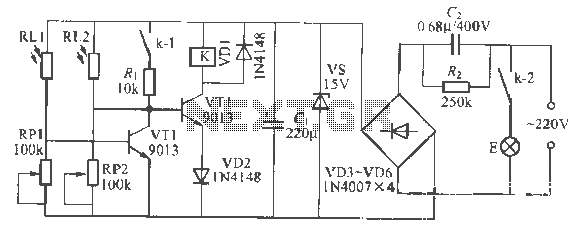
led dimmer circuit

This schematic illustrates a simple yet effective LED dimmer circuit utilizing the well-known voltage regulator IC LM317T. The LM317T can function as a current regulator, as demonstrated in this circuit. It features ten super bright white LEDs, although the quantity of LEDs can be increased as desired. A 200-ohm variable resistor is incorporated to adjust the current or brightness of the LEDs. The total output current of the LM317 is 1.5A, which necessitates the use of a separate current-limiting resistor for each LED to safeguard them against exceeding the maximum current output from the IC.
The LED dimmer circuit employs the LM317T voltage regulator, which is versatile due to its ability to regulate both voltage and current. This characteristic is particularly useful in LED applications where consistent brightness is required. The circuit is designed to accommodate ten super bright white LEDs, allowing for flexibility in the number of LEDs used based on specific lighting needs.
The variable resistor, rated at 200 ohms, serves as a means to adjust the LED brightness by varying the current flowing through the circuit. By changing the resistance, the user can effectively control the luminosity of the LEDs, making this circuit suitable for applications where adjustable lighting is beneficial.
Each LED in the circuit is paired with a current-limiting resistor. This design choice is critical, as it prevents excessive current from damaging the LEDs. The LM317T can supply a maximum current of 1.5A, which is adequate for driving multiple LEDs. However, to ensure longevity and reliability, the inclusion of individual current-limiting resistors for each LED is essential. These resistors are calculated based on the forward voltage and current specifications of the LEDs used, ensuring that each LED operates within its safe limits.
Overall, this LED dimmer circuit is a practical solution for those seeking to create adjustable lighting with super bright LEDs, leveraging the capabilities of the LM317T voltage regulator for optimal performance and safety.Here is a very easy and useful schematic of an LED dimmer circuit. The circuit is using a famous voltage regulator IC LM317T. This IC can also be used as a current regulator, like it is used in the following circuit. In this circuit we have used 10 super bright white LEDs, but the number of LEDs can be increase if desired. The 200 ohms variable r esistor is used to control the current or brightness of LEDs. The total output current of LM317 is 1. 5A, due to which we have used a separate current limiting resistor with each LED which will protect them on the maximum current output from the IC. 🔗 External reference
The LED dimmer circuit employs the LM317T voltage regulator, which is versatile due to its ability to regulate both voltage and current. This characteristic is particularly useful in LED applications where consistent brightness is required. The circuit is designed to accommodate ten super bright white LEDs, allowing for flexibility in the number of LEDs used based on specific lighting needs.
The variable resistor, rated at 200 ohms, serves as a means to adjust the LED brightness by varying the current flowing through the circuit. By changing the resistance, the user can effectively control the luminosity of the LEDs, making this circuit suitable for applications where adjustable lighting is beneficial.
Each LED in the circuit is paired with a current-limiting resistor. This design choice is critical, as it prevents excessive current from damaging the LEDs. The LM317T can supply a maximum current of 1.5A, which is adequate for driving multiple LEDs. However, to ensure longevity and reliability, the inclusion of individual current-limiting resistors for each LED is essential. These resistors are calculated based on the forward voltage and current specifications of the LEDs used, ensuring that each LED operates within its safe limits.
Overall, this LED dimmer circuit is a practical solution for those seeking to create adjustable lighting with super bright LEDs, leveraging the capabilities of the LM317T voltage regulator for optimal performance and safety.Here is a very easy and useful schematic of an LED dimmer circuit. The circuit is using a famous voltage regulator IC LM317T. This IC can also be used as a current regulator, like it is used in the following circuit. In this circuit we have used 10 super bright white LEDs, but the number of LEDs can be increase if desired. The 200 ohms variable r esistor is used to control the current or brightness of LEDs. The total output current of LM317 is 1. 5A, due to which we have used a separate current limiting resistor with each LED which will protect them on the maximum current output from the IC. 🔗 External reference





